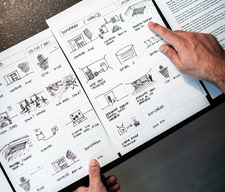A simple storyboard editor
Storyteller

© Photo by dix sept on Unsplash
Krita 5 includes an editor that makes it easy to prepare storyboards for any purpose, including unexpected ones.
Krita's new Storyboard Docker helps you prepare storyboards for animations and other multimedia projects [1].
If you want to visually create and narrate a story, a storyboard is an essential tool. Artists use storyboards in film, dance, comic strips, animations, and more. StudioPigeon [2] describes a storyboard as a visual representation of your story's narrative flow, scene by scene, drawn as simply as possible without using colors, backgrounds, character design, soundtracks, or any other details that you add later after the storyboard has been accepted.
A storyboard offers the quickest and easiest way to provide an overview of your story, check if it makes sense, and share it with others. Storyboards are used in creating all but the very simplest visual stories because they minimize the risk of wasting a lot of time – and possibly even money – due to confusion or misunderstanding.
[...]
Buy this article as PDF
(incl. VAT)
Buy Linux Magazine
Subscribe to our Linux Newsletters
Find Linux and Open Source Jobs
Subscribe to our ADMIN Newsletters
Support Our Work
Linux Magazine content is made possible with support from readers like you. Please consider contributing when you’ve found an article to be beneficial.

News
-
Mozilla Plans to AI-ify Firefox
With a new CEO in control, Mozilla is doubling down on a strategy of trust, all the while leaning into AI.
-
Gnome Says No to AI-Generated Extensions
If you're a developer wanting to create a new Gnome extension, you'd best set aside that AI code generator, because the extension team will have none of that.
-
Parrot OS Switches to KDE Plasma Desktop
Yet another distro is making the move to the KDE Plasma desktop.
-
TUXEDO Announces Gemini 17
TUXEDO Computers has released the fourth generation of its Gemini laptop with plenty of updates.
-
Two New Distros Adopt Enlightenment
MX Moksha and AV Linux 25 join ranks with Bodhi Linux and embrace the Enlightenment desktop.
-
Solus Linux 4.8 Removes Python 2
Solus Linux 4.8 has been released with the latest Linux kernel, updated desktops, and a key removal.
-
Zorin OS 18 Hits over a Million Downloads
If you doubt Linux isn't gaining popularity, you only have to look at Zorin OS's download numbers.
-
TUXEDO Computers Scraps Snapdragon X1E-Based Laptop
Due to issues with a Snapdragon CPU, TUXEDO Computers has cancelled its plans to release a laptop based on this elite hardware.
-
Debian Unleashes Debian Libre Live
Debian Libre Live keeps your machine free of proprietary software.
-
Valve Announces Pending Release of Steam Machine
Shout it to the heavens: Steam Machine, powered by Linux, is set to arrive in 2026.

